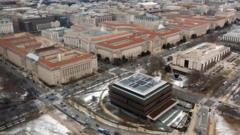The Smithsonian Institution, comprising over 20 museums and research centers beloved by millions, is under scrutiny from the Trump administration. An executive order signed by President Trump mandates a removal of what he terms "improper, divisive, or anti-American ideology" from these cultural sites, which draw an annual attendance of 15 to 30 million visitors in Washington D.C. and New York City.
The order, titled "Restoring Truth and Sanity to American History," tasks Vice-President JD Vance, now a regent on the Smithsonian Board, with enforcing these cultural changes. Trump has urged the restoration of federal properties—including parks and memorials—that he claims have experienced improper alterations to distort historical truths.
Within the executive order, the President specified that federal funding for Smithsonian exhibitions should be contingent upon their alignment with a vision he feels promotes national unity rather than division based on race. He specifically criticized the upcoming American Women's History Museum for its alleged plans to recognize transgender identities, and he accused the National Museum of African American History and Culture of labeling core American values, like hard work and family structures, as characteristics of "White culture."
Beyond the Smithsonian, Trump's cultural overhaul includes direction to Secretary of the Interior Doug Burgum to spearhead restoration of historical sites like Independence Hall in Philadelphia as the nation gears up for the 250th anniversary of the Declaration of Independence. This move is part of Trump’s broader effort to counter what he sees as a cultural battle influenced by "woke" left ideologies that he believes undermine traditional American values.
This latest directive follows Trump's previous attempts to eliminate diversity initiatives within the federal government, which sparked legal challenges. Critics of the administration argue that these actions risk erasing essential narratives from American history and reshaping public institutions to reflect a narrow political agenda.
The order, titled "Restoring Truth and Sanity to American History," tasks Vice-President JD Vance, now a regent on the Smithsonian Board, with enforcing these cultural changes. Trump has urged the restoration of federal properties—including parks and memorials—that he claims have experienced improper alterations to distort historical truths.
Within the executive order, the President specified that federal funding for Smithsonian exhibitions should be contingent upon their alignment with a vision he feels promotes national unity rather than division based on race. He specifically criticized the upcoming American Women's History Museum for its alleged plans to recognize transgender identities, and he accused the National Museum of African American History and Culture of labeling core American values, like hard work and family structures, as characteristics of "White culture."
Beyond the Smithsonian, Trump's cultural overhaul includes direction to Secretary of the Interior Doug Burgum to spearhead restoration of historical sites like Independence Hall in Philadelphia as the nation gears up for the 250th anniversary of the Declaration of Independence. This move is part of Trump’s broader effort to counter what he sees as a cultural battle influenced by "woke" left ideologies that he believes undermine traditional American values.
This latest directive follows Trump's previous attempts to eliminate diversity initiatives within the federal government, which sparked legal challenges. Critics of the administration argue that these actions risk erasing essential narratives from American history and reshaping public institutions to reflect a narrow political agenda.





















